

Scribble is truly a befitting name for this collection of miniatures created by composer and sound designer Jacob Sachs-Mishalanie. Recorded at his home this past Summer, the short, sweet pieces really are like aural scribbles in a notebook. Slightly chaotic and seemingly unintentional, the 7 tracks exhibit a childlike wonder, a fascination with how various sounds or rhythms work (or don’t work) in tandem.
At the time of writing, Sachs-Mishalanie was particularly interested in exploring loose evolving patterns, utilizing sounds that feel both natural and synthetic - for instance atmospheric field recordings, uncanny MIDI xylophones, and clumsy samples of his own voice. The resulting pieces each explore a singular environment, in which various elements (often quite literally) bounce off each other. There is no obvious logic to how these pieces evolve and behave, but there is something uniquely captivating about these recordings - they are surreal, yet eerily familiar.[Words by Adam Badí Donoval]
A1. Aogaeru (2:42)
A2. Carrot World (2:38)
A3. aq (0:34)
A4. Thinkin’ Things (2:15)
B1. Sprout (1:52)
B2. Aquatic Solutions (3:57)
B3. Scribble (1:47)
A2. Carrot World (2:38)
A3. aq (0:34)
A4. Thinkin’ Things (2:15)
B1. Sprout (1:52)
B2. Aquatic Solutions (3:57)
B3. Scribble (1:47)
Recorded at Home in Brooklyn, NY, Summer 2020
Field Recordings:
● (A1) G Train [9.18.2018]
● (A2) Roasted Carrots at Home [3.8.2020]
● (A4) Arcade in Kyoto [7.25.2019]
● (B1) Backyard Bugs at Home [8.12.2020]
● (B2) Rain at Home [5.1.2020]
All Sounds by Jacob Sachs-Mishalanie
jsmishalanie.com
Mastered by Angel Marcloid
angelmarcloidav.com
Artwork and layout by Paulina Ufnal & Janek Ufnal
Field Recordings:
● (A1) G Train [9.18.2018]
● (A2) Roasted Carrots at Home [3.8.2020]
● (A4) Arcade in Kyoto [7.25.2019]
● (B1) Backyard Bugs at Home [8.12.2020]
● (B2) Rain at Home [5.1.2020]
All Sounds by Jacob Sachs-Mishalanie
jsmishalanie.com
Mastered by Angel Marcloid
angelmarcloidav.com
Artwork and layout by Paulina Ufnal & Janek Ufnal
I listen in my house
I listen in my house [is / will be] a series of at home performance videos involving live field recordings & algorithmic music.
[1] streamed on RGB.dog Bedroom Liveout #2, April 25, 2020


‘Live code your track live' is a video series created by Umanesimo Artificiale, in which algorave and algorithmic music artists code a track live from scratch in up to 30 minutes while explaining their creative process and the technology they are using and/or they have uniquely built.
The resulting tracks make up the first release by Umanesimo Artificiale multimedia label.
The resulting tracks make up the first release by Umanesimo Artificiale multimedia label.
flintstone chime bottle voice
musique concrète
purchase record / free digital dl on bandcamp
5” lathe cut record, edition of 35
& free digital download
released February 29 2020


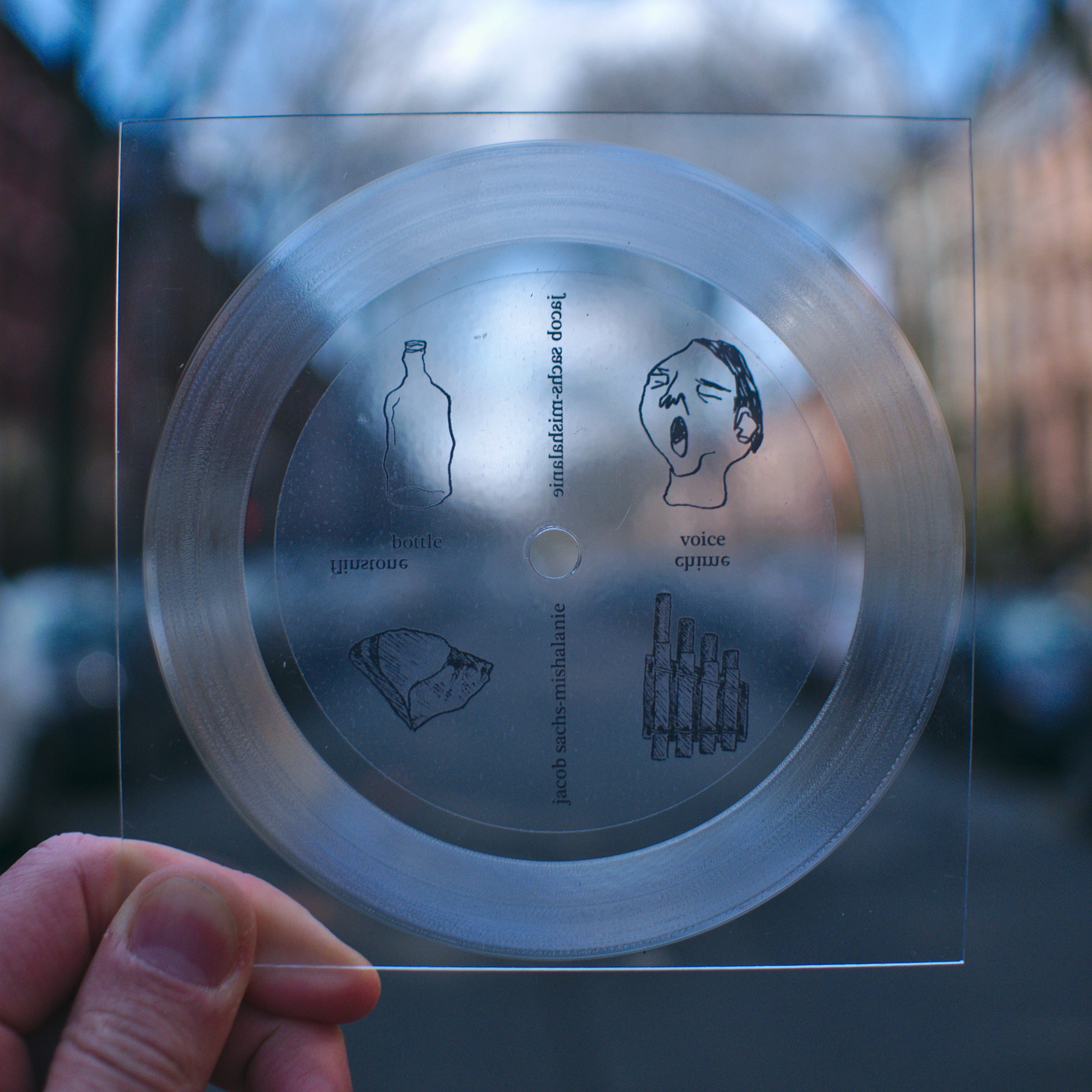

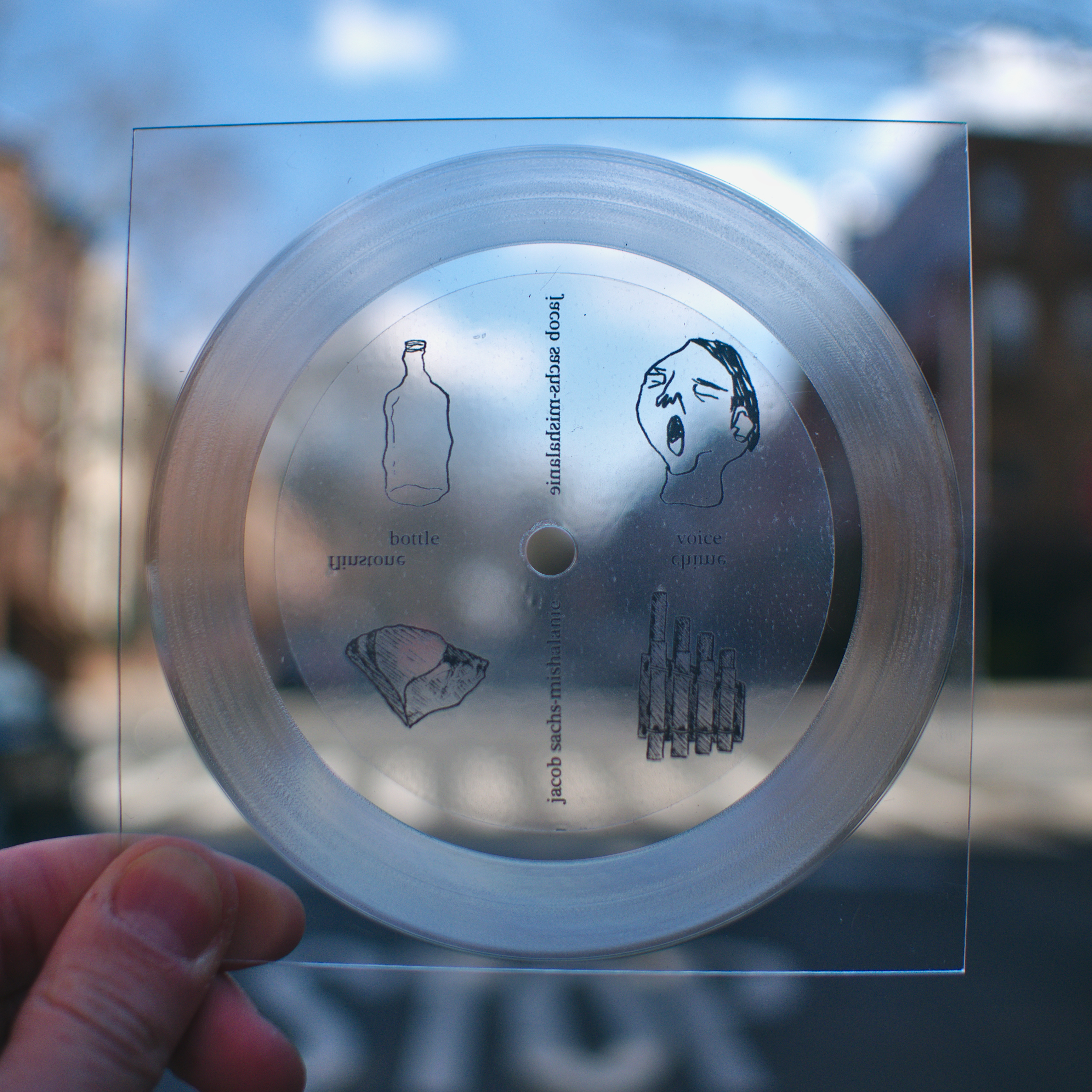


music, mix, & master by Jacob Sachs-Mishalanie
drawings by R. Turner
lathe cut records by Precarian Cuts
drawings by R. Turner
lathe cut records by Precarian Cuts
These pieces were inspired by sounds I found and objects I recorded: sound effects from the Flintstones, my grandma’s chimes, a water
bottle, and my voice. I like seeing the variety of sounds ordinary objects can make
and find their origin stories meaningful when later combining them in a piece.
These pieces were also a response to a summer studying Pierre Schaeffer for my PhD exams & dissertation. His music and thinking wrestled with what it means for a sound to be musical or anecdotal, and how recording transforms or erases the meaning of a sound.
This also led me to have this music cut to plexiglass records, similar to the technology Schaeffer used in his early pieces. Each of the 35 records were hand cut and they all end with a unique closed groove at that loops endlessly. I plan to use these records as instruments and sound sources.
These pieces were also a response to a summer studying Pierre Schaeffer for my PhD exams & dissertation. His music and thinking wrestled with what it means for a sound to be musical or anecdotal, and how recording transforms or erases the meaning of a sound.
This also led me to have this music cut to plexiglass records, similar to the technology Schaeffer used in his early pieces. Each of the 35 records were hand cut and they all end with a unique closed groove at that loops endlessly. I plan to use these records as instruments and sound sources.
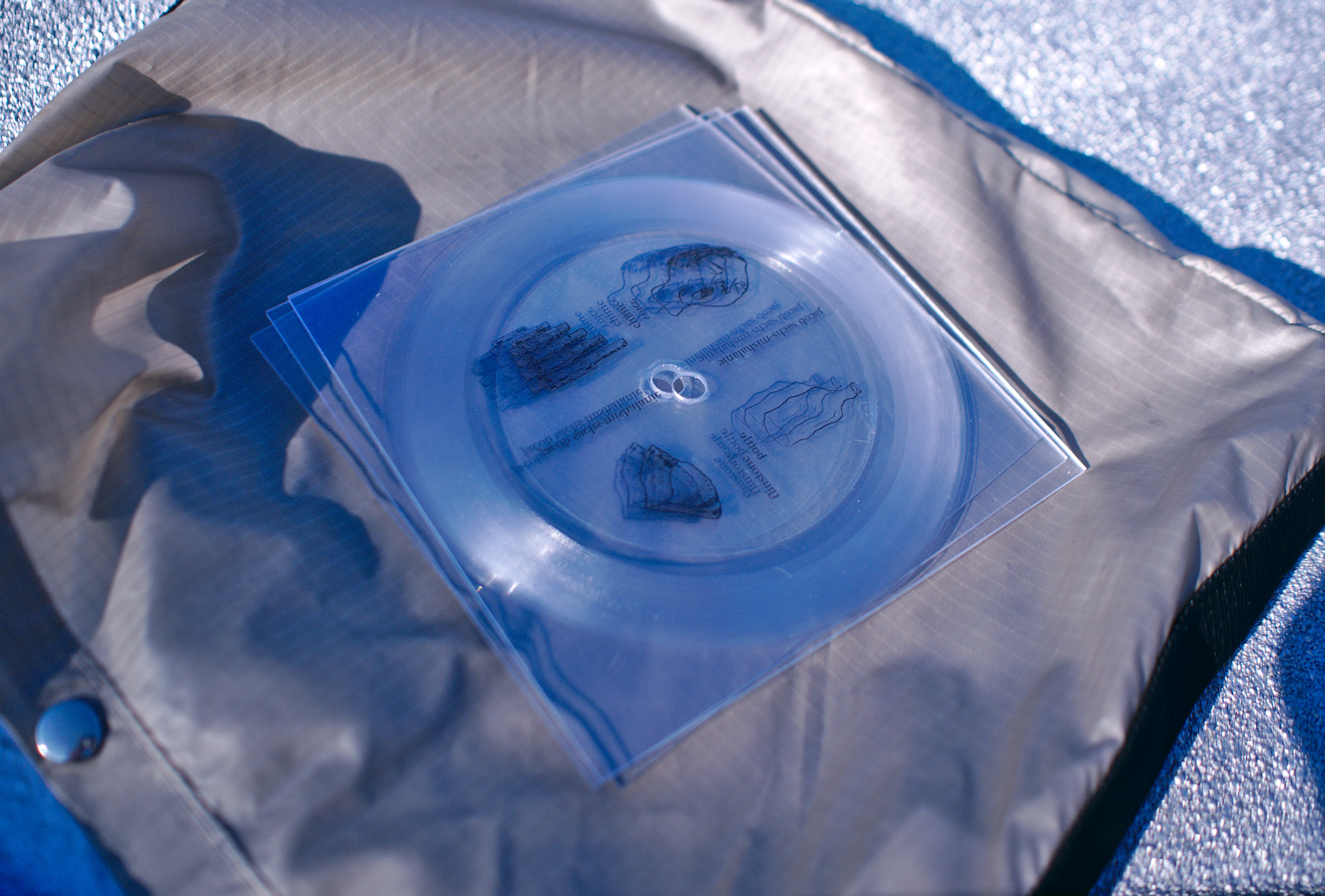
Clarinet and Shadow
Clarinet & Electronics
Written for Gleb Kanasevich
In residence with GC Composers, Spring 2021
video
score
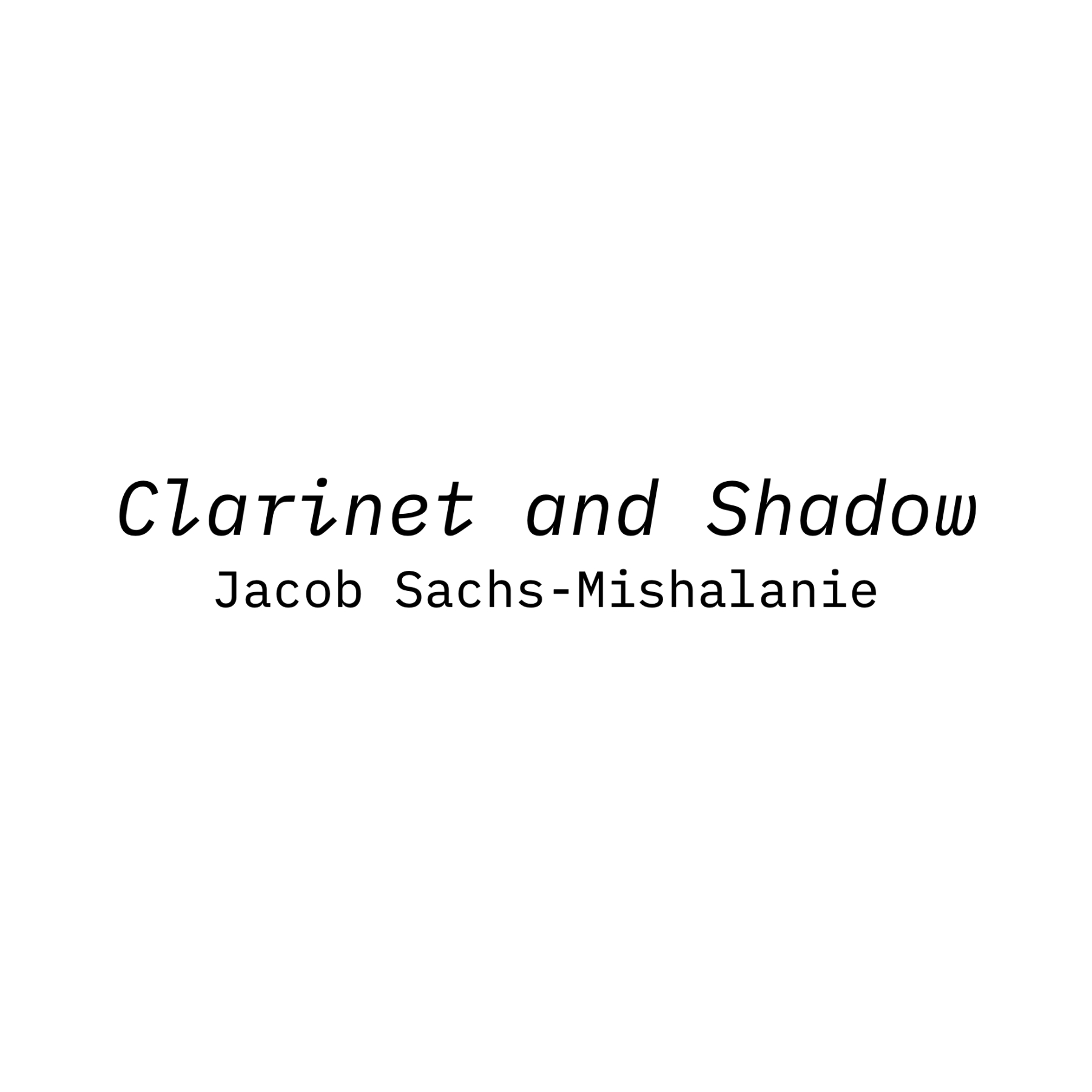
In Clarinet and Shadow, live electronics pitch shift the clarinet to create
harmonies and add the sound of an artificial instrument. The electronics are the
clarinet’s shadow: unreal, always there, and tied to its movement.
More information on the electronics can be found in the score. In this first realization, seen in the video above, the electronics were performed with a 16n controlling Ableton. The clarinet mics were fed into 13 different tracks. Each track had the pitch shifting plugin Little AlterBoy by Soundtoys, set to particular intervals that are unchanged (see the image to the right). The first 13 faders on the 16n adjust the volume of each of these tracks, mixing a pitch shifted sound with the original sound to create harmonies. To create the artificial instrument, I took a sample of Gleb from a rehearsal and loaded it into Ableton’s Sampler Instrument. Using a simple max-for-live device, the chord is triggered every time faders 14 & 15 are raised above 0. These faders also control the volume of these instruments. Lastly, this same max-for-live device mapped fader 16 to the pitch bend of the sampler instruments. To get the proper pitch bend range, the first sampler was set to +/- 1 semitone, and the second was set to +/- 2 semitones.
For this version, I was aiming for a somewhat natural sound in the electronics. This is why I chose to use the sampler & Soundtoys plugin. In a future version, I think it would be interesting to aim for a more artificial or uncanny electronic sound, with a synthesized clarinet & pitch shifter with more artifacts. I hope this piece can be a platform for experimentation.
For this version, I was aiming for a somewhat natural sound in the electronics. This is why I chose to use the sampler & Soundtoys plugin. In a future version, I think it would be interesting to aim for a more artificial or uncanny electronic sound, with a synthesized clarinet & pitch shifter with more artifacts. I hope this piece can be a platform for experimentation.

bend the slats apart and look through
Quartet & Electronics
Written for the Unheard-of//Ensemble
for the 2020 CCI//Sessions
bandcamp
score
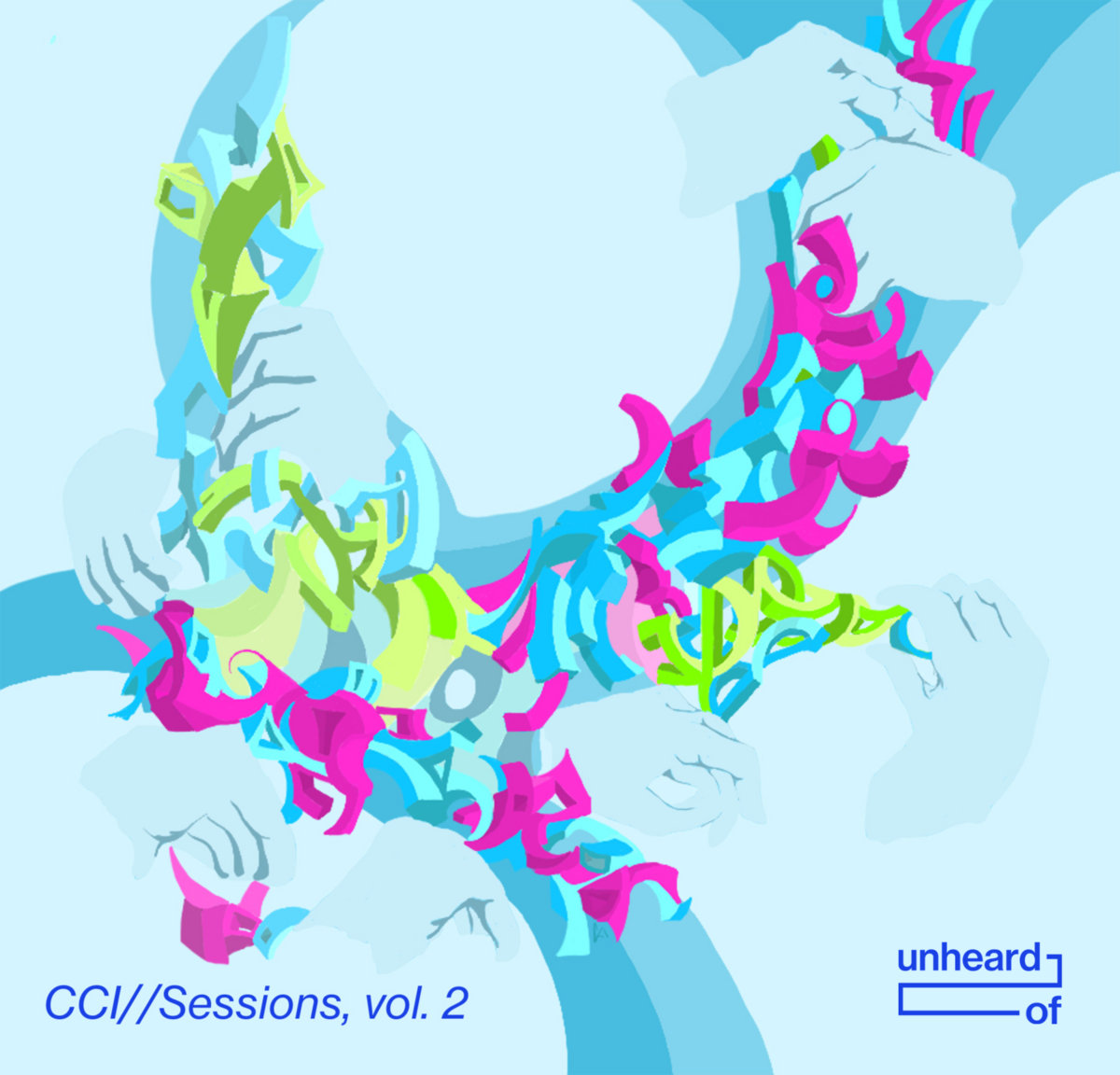
Written during the pandemic of 2020, Bend the slats apart and look through was conceived as a recording project rather than a live piece. The role of a pianist as hybridized with an audio engineer, and the ensemble as a meta-instrument played by the keyboardist-engineer. To play the ensemble, (or mix the recording, depending on your preferred metaphor), the sustain pedal turns on and off amplification from close mics, while the keys amplify narrow frequency bands tuned to the pitch of each key. The changing amplification creates a dynamic listening perspective, cutting between brittle intimacy, soft distance, and harmonies filtered from noise and overtones.
hover between something and something else
String Quartet & Electronics
Written for the Mivos Quartet
in residence at the CUNY Graduate Center, Spring 2018.
Finalist in the 2020 Lake George Music Festival Composition Competition.
score

In a scene towards the end of the film Through a Glass Darkly, an ambulance helicopter descends and a door in a house opens. Inside, Karin sees the door opened by god, while the rest of her family sees the door opened by vibrations and wind. In this piece, a recording of a helicopter, or white noise filtered to imitate the recording of a helicopter, act as a sound blanket, covering the acoustic string quartet. While some acoustic sounds emerge, most are hidden from ear. Amplification is used to generate an additional voice, distant and artificial, rather than to reinforce the acoustic sound. These voices may be heard as singular, inseparable, from a common source – or, detached, from different worlds, and irreconcilable – or, possibly, some uncanny place between.
I if I
Commissioned by the VIPA Festival for the Mivos Quartet Premiered July 7, 2017 in Valencia, Spain
Finalist for the 2018 World New Music Days nominated by New Music Miami.
score

I if I is the third in a series of pieces exploring the differences in our interpretation of
meaning, expression, and genuineness in acoustic and electronic sounds. Acoustic tones are
juxtaposed with amplified, pre-recorded, and synthesized tones, and string noise is put up against white
noise and recorded water sounds. Here are a few related questions: Is a recording merely an image of a
past sound? Is an amplified sound less ‘real’ if the speaker is separated from the instrument? If we
interpret a sound as ‘artificial,’ do we take it less seriously? Is there some space between ‘real’ and
‘artificial’?

program
note: (by Matt Sandahl)
Daisy, Hold Into takes as its starting point the aesthetic tensions that emerge between electronic and acoustic sound – or more precisely, between pre-recorded material sounding from speakers and live material produced by traditional instruments. Rather than try and reconcile these two worlds, this piece lays bare the ontological differences between the two categories by means of simple juxtaposition. Extremely spare and austere musical material is distributed between an acoustic piano and an electronic copy of the same instrument, in a manner that foregrounds nuances of timbre and spatial diffusion.
This technique of letting musical properties reveal themselves through juxtaposition becomes an operative principle of the piece in general, working across several parametrical registers. Contrasting musical states are not negotiated alongside any sort of continuum. Rather, they are placed plainly beside each other, interwoven into a kind of mosaic. There is no discursive logic or linear process guiding the music along, but instead an intimate sense of free play. This is music that encourages a child-like re-encounter with the world, with all of the freshness, sensuality, and strangeness that such an experience entails.
Daisy, Hold Into takes as its starting point the aesthetic tensions that emerge between electronic and acoustic sound – or more precisely, between pre-recorded material sounding from speakers and live material produced by traditional instruments. Rather than try and reconcile these two worlds, this piece lays bare the ontological differences between the two categories by means of simple juxtaposition. Extremely spare and austere musical material is distributed between an acoustic piano and an electronic copy of the same instrument, in a manner that foregrounds nuances of timbre and spatial diffusion.
This technique of letting musical properties reveal themselves through juxtaposition becomes an operative principle of the piece in general, working across several parametrical registers. Contrasting musical states are not negotiated alongside any sort of continuum. Rather, they are placed plainly beside each other, interwoven into a kind of mosaic. There is no discursive logic or linear process guiding the music along, but instead an intimate sense of free play. This is music that encourages a child-like re-encounter with the world, with all of the freshness, sensuality, and strangeness that such an experience entails.
The Loop
Site specific devised theater piece by students at LaGuardia Community College, guided by a team of professors: Stefanie Sertich & Lindsay Timmington, directors; Irina Kruzhilina, visual design; Hansol Oh, stage manager; Jacob Sachs-Mishalanie, sound design.
Fall 2019

In Fall 2019, I worked on this project as a Mellon Humanities Alliance Teaching Fellow. Throughout the semester, students researched, wrote, designed, and acted in this piece, exploring LaGuardias past, present, and future. Along with writing original ambient music, I conducted sound workshops, guided students in recording and editing audio pieces, and taught students how to perform and mix live sound.
Black Garden
Play by Gordon Penn, Directed by Arthur Makaryan, Score & Sound Design by Jacob Sachs-Mishalanie.
Premiered at Théâtre de l’Opprimé, Paris, September 2018
Reviews:
- Broadway World: “…the music cues were sharp and clear, making the transitions feel like we were really going somewhere.
- Symanews


Simulacrum
Multimedia chamber opera by Longfei Li, Yangzhi Ma, Peter Kramer, Meng Wang, James Diaz, and guest composer Reiko Füting. Directed by Arthur Makaryan, Sound design and live sound engineering by Jacob Sachs-Mishalanie.
Premiered at Three Legged Dog, Summer 2018
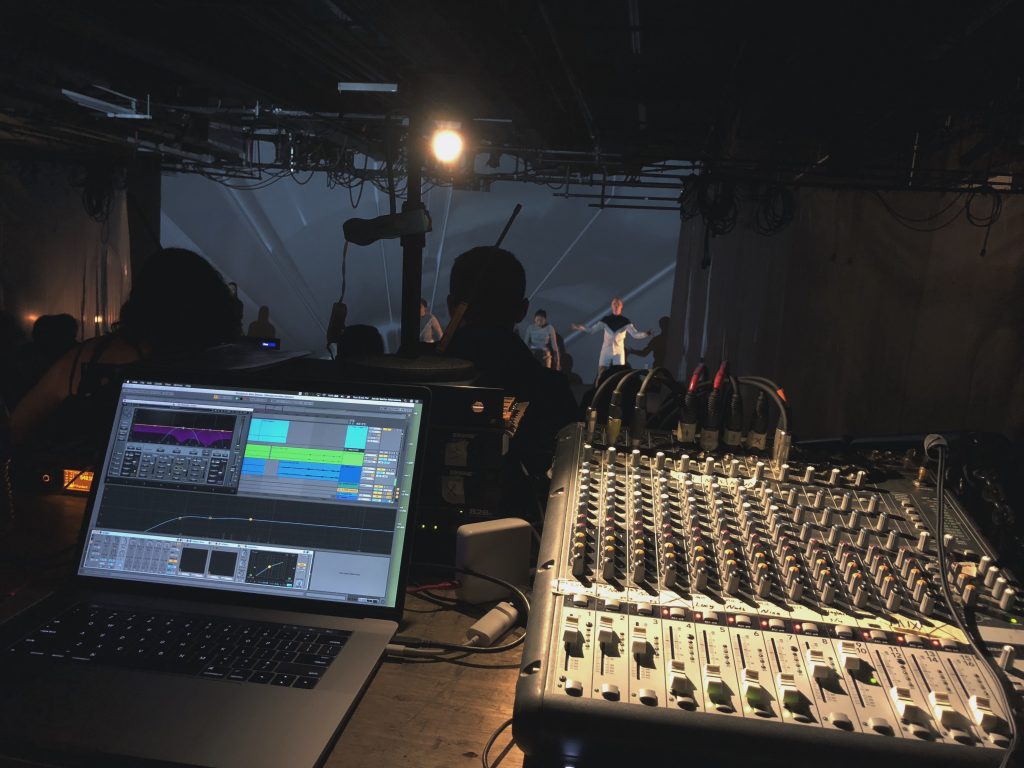
I was hired to sound design and live sound engineer this project.
This involved creating sound effects, processing live vocals, recording and mixing dialog, sync with video, managing all sound equipment and wireless mics, and engineering all performanes.
Eucalyptus
3 Song EP
released August 2016

Eucalyptus is three songs about writing songs. The lyrics started as self reflective wandering thoughts when I couldn’t write anything that felt genuine and expressive. Writing self-consciously about writing, music, and thinking allowed me to embed into these songs unself-conscious ideas about life and other things..
The beats were started in January 2013 when visiting the house where we currently live before we lived here (original file names: “ash house beat”, “ash house beat 3”, & “ash house beat 4”). The “Marble Words” music video was made here too, but much later. While the video started as an experiment to learn about animation and photoshop, the process and the aesthetic felt very close to the songs. The colored light from most frames is the same LED bulb that lit the page when I was writing the song Eucalyptus, which appears in the lyrics. The repetition of frames and continuous addition of new layers felt like the gradual and tedious process that shaped the beats and lyrics. The clerical feeling of printing and placing each frame felt like the non-creative thought of the lyrics. The balance of this mechanical type activity and imperfections like the slight frame to frame changes is important to me.
For Reality TV
6 track instrumental pop EP
released April 16, 2016


Music written for & rejected from a reality TV show.
Written & recorded by Jacob Sachs-Mishalanie
Mastered by Zeno Pittarelli
Cassette by Newlywed Records
Mastered by Zeno Pittarelli
Cassette by Newlywed Records
Sleep Stir
6 Song chamber pop EP
released October 4, 2013
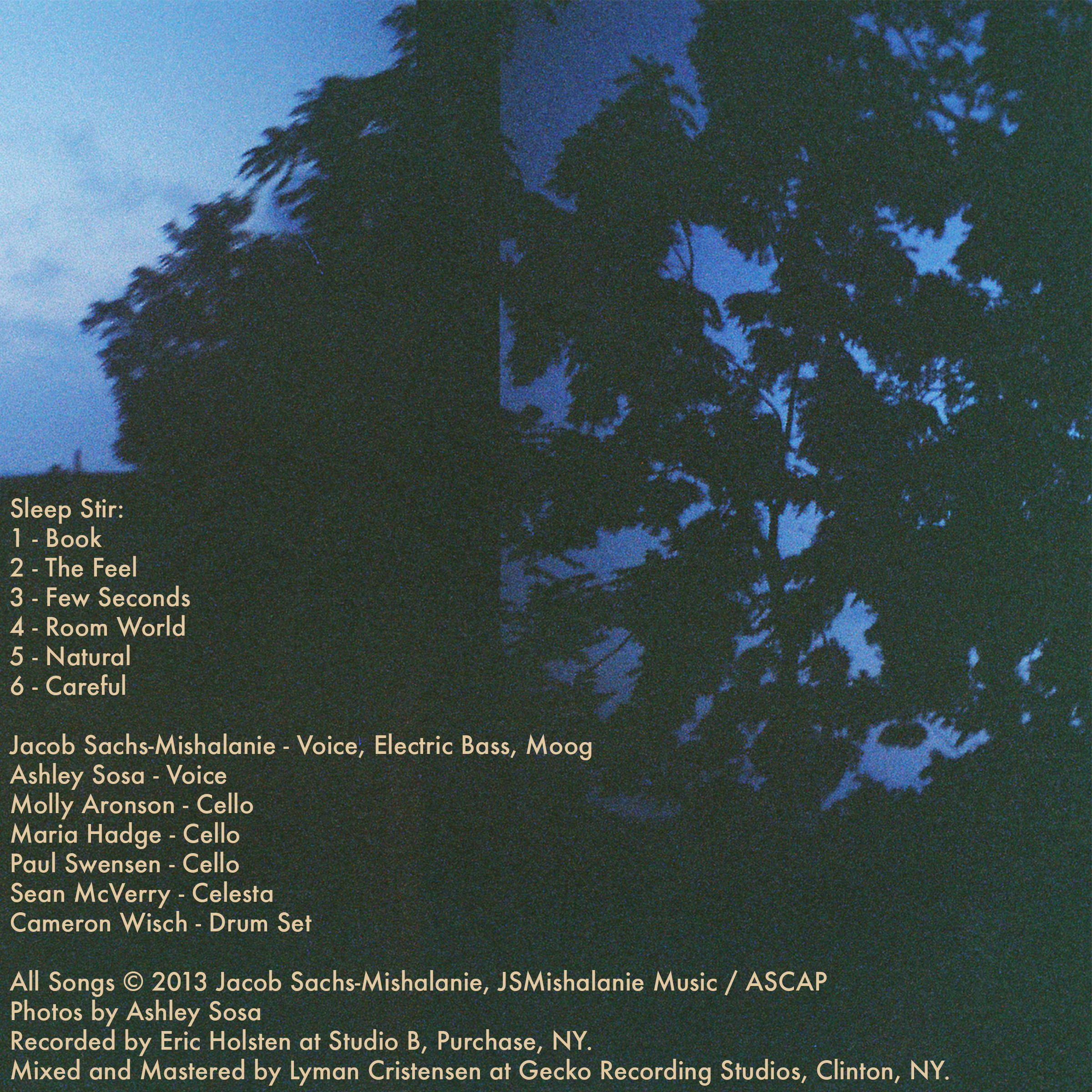
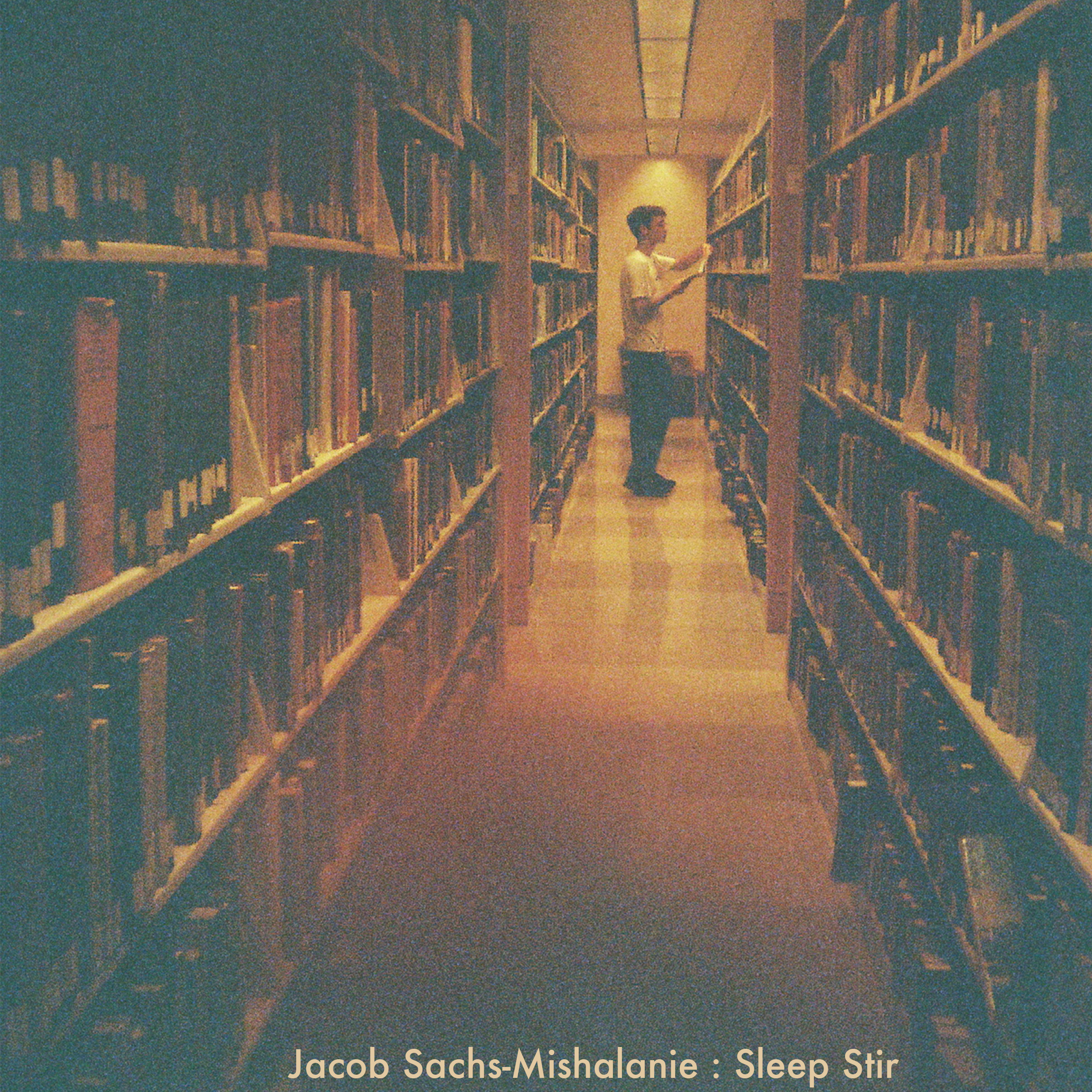
Recorded by Eric Holsten at Studio B, Purchase, NY. - shocking-twist.bandcamp.com
Mixed and Mastered by Lyman Cristensen at Gecko Recording Studios, Clinton, NY. - www.geckorecordingstudio.com
Photos by Ashley Sosa
Mixed and Mastered by Lyman Cristensen at Gecko Recording Studios, Clinton, NY. - www.geckorecordingstudio.com
Photos by Ashley Sosa
Jacob Sachs-Mishalanie - Voice, Electric Bass, Moog
Ashley Sosa - Voice
Molly Aronson, Maria Hadge, & Paul Swensen - Cello
Sean McVerry - Celesta
Cameron Wisch - Drum Set
Ashley Sosa - Voice
Molly Aronson, Maria Hadge, & Paul Swensen - Cello
Sean McVerry - Celesta
Cameron Wisch - Drum Set
Split EP
5 song pop EP
released June 29, 2011
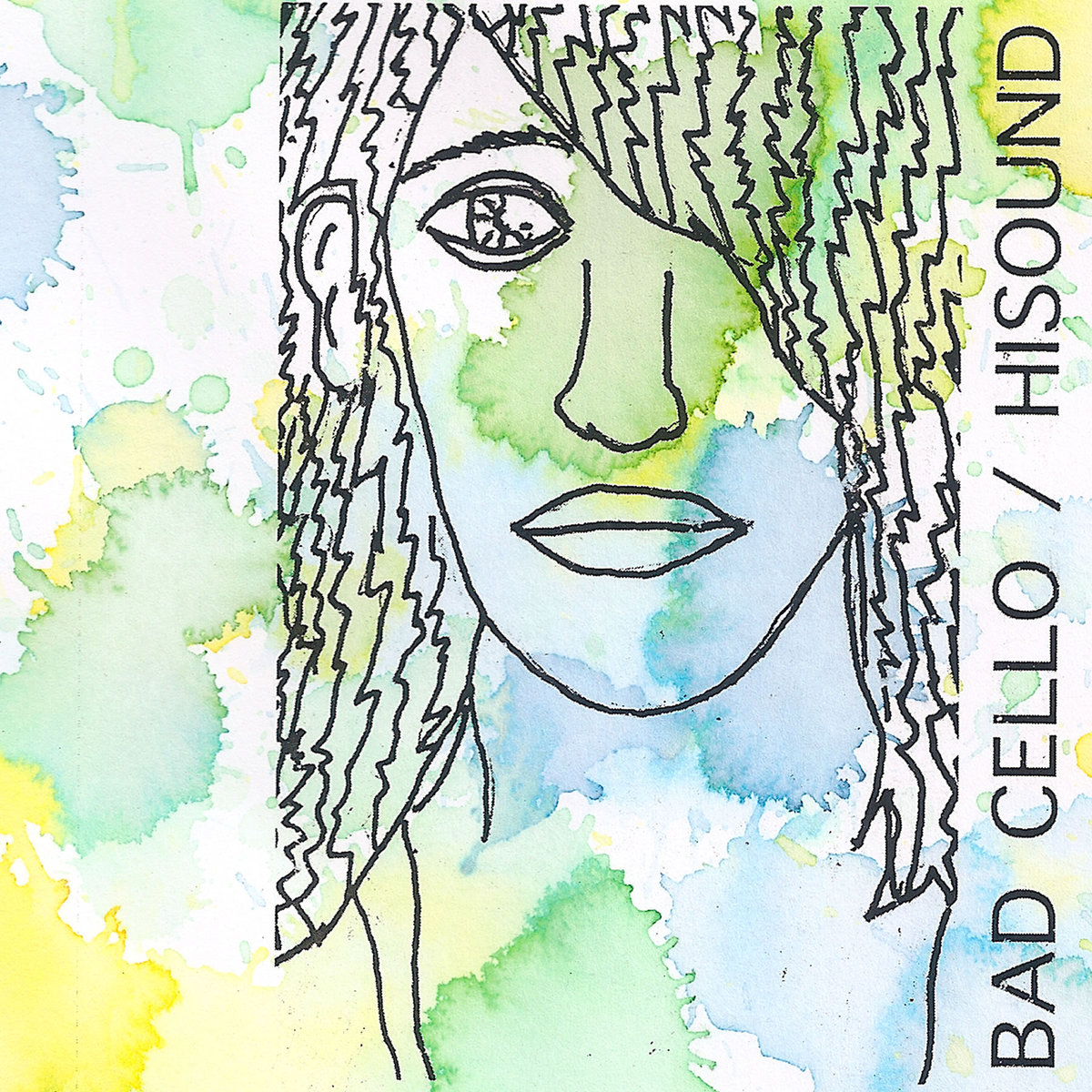




Written & recorded by Jacob Sachs-Mishalanie
Split EP with Zeno Pittarelli handmade cassette self released
Split EP with Zeno Pittarelli handmade cassette self released